Optimization of Operation Strategy of Multi-Islanding Microgrid Based on Double-Layer Objective
Abstract
1. Introduction
- (1)
- In terms of optimal scheduling, shared energy storage devices are introduced between islanded microgrids to integrate power resources and realize resource sharing. The improved grey wolf algorithm (GWO) is used to optimize the scheduling model. It demonstrates that incorporating shared energy storage capabilities could greatly decrease the extent of wasted wind and solar power generation and enhance the efficiency of resource utilization.
- (2)
- From an economic point of view, a more reasonable use of shared energy storage is formulated by alternating quotations and compared with the disposition of off-grid storage. The results demonstrate a significant reduction in the capacity requirements for shared energy storage, the maximum charging and discharging capabilities of the storage system, and the overall investment costs associated with energy storage power stations.
- (3)
- In this paper, the improved GWO is used, and the scheduling is optimized. Simulation results from typical scenarios reveal that in comparison to stand-alone off-grid energy storage configurations for individual microgrids, a shared energy storage power station enables the optimization of power flows, leading to a mutually advantageous scenario where both energy storage providers and users reap benefits.
2. Modeling of Islanded Microgrid System
- (1)
- Optimized scheduling module
- (2)
- Transaction bargaining module
3. Mathematical Model of Each Subject
3.1. Distributed Power Station Model
3.2. Model of Gas Turbine
3.3. Fuel Cell Model
3.4. Shared Energy Storage Model
3.5. Microgrid Operation Model
- (1)
- Transferable load
- (2)
- Interruptible load considering demand response
4. An Improved GWO Optimization Model Based on BAS
4.1. Optimal Scheduling Model Based on Improved GWO
- (1)
- Input the microgrid load prediction value , photovoltaic output prediction value , wind power output prediction value , abandoned wind and abandoned light penalty coefficient , , , and the maintenance cost coefficient of each piece of equipment, upper and lower limits of output values, and record the number of iterations as ;
- (2)
- With the goal of optimizing the power generation expenditure of the microgrid, the output of each subject is calculated as the Wolf individual fitness value;
- (3)
- The calculated fitness value of each gray Wolf is ranked. The first three are recorded as , , and respectively. The corresponding location information is , , and respectively;
- (4)
- If the iteration ends, this value is the optimal result and outputs this value; otherwise, continue to perform step 5;
- (5)
- Updated the location of the Gray Wolf to re-elect new wolves , , and ;
- (6)
- Update iterations, ;
- (7)
- Verify whether the termination condition is met, and if so, verify whether it falls into the local optimal solution; if it is satisfied, jump out of the loop and output the final result; if it is not satisfied, use the BAS to gain a new search direction, and Revert back to step (2) and proceed with the solution.
4.2. Service Fee Optimization Formulation Model Based on ADMM
- (1)
- Input the original data variables of various parameters, such as the prediction data of the PV station, wind power station, load forecast value, Lagrange penalty factor , the maximum number of iterations, and convergence accuracy.
- (2)
- For the main body of the microgrid, the mathematical model of the PV station, wind power station, gas turbine, and load is used to calculate the expected service fee of the microgrid to share energy storage under the maximization of microgrid revenue.
- (3)
- For the core entity of the microgrid, the mathematical model of the PV station, wind power station, gas turbine, and load is calculated, and the expected service fee of the microgrid to share energy storage is under the maximization of microgrid revenue.
- (4)
- Update the Lagrange multiplier and iterations.
- (5)
- Determine whether the deviation value of and is within the allowable convergence accuracy range, and if it is greater than the convergence accuracy requirement, return step 2 to continue the iteration; if it is less than the convergence accuracy requirement, the iteration ends, and the optimized electricity price is output as the result.
5. Case Study
5.1. Island Multi-Microgrid Is Equipped with Independent Energy Storage
- Microgrid I: PV + load;
- Microgrid II: Wind power + load;
- Microgrid III: PV + Wind power + load.
- (1)
- Microgrid I is configured with independent energy storage
- (2)
- Microgrid II is configured with independent energy storage
- (3)
- Microgrid III is configured with independent energy storage
5.2. Islanded Multi-Mcrogrid Is Equipped with Shared Energy Storage
6. Conclusions and Prospects
6.1. Conclusions
- (1)
- Formulate the optimal scheduling model under the multi-microgrid island operation mode. Shared energy storage gives full play to the complementarity of power consumption among microgrids to reduce wind and light abandonment rates and adopts an improved gray Wolf algorithm to optimize scheduling. According to the simulation results of the example, compared with the independent energy storage configuration of each microgrid, the shared energy storage power station can optimize the power flow and achieve a win-win situation between energy storage and users.
- (2)
- Optimize the transaction price model under the multi-microgrid island operation mode. Using ADMM to negotiate the price, the results show that compared with the configuration of independent energy storage, the shared energy storage capacity and investment costs are greatly reduced, and the utilization rate of energy storage capacity is greatly improved.
6.2. Prospects
- (1)
- The microgrid mathematical model established in this paper is relatively simple. In the future, it is necessary to consider the actual scenario state, consider the addition of more types of agents, and establish more abundant application scenarios.
- (2)
- This paper only analyzes the operation status of shared energy storage participation in isolated island operation mode. In fact, shared energy storage also plays a great role in peak regulation and frequency regulation in grid-connected operation modes. In the future, it is necessary to continue to explore the study of shared energy storage participation in peak regulation and frequency regulation operation mode in grid-connected mode.
Author Contributions
Funding
Data Availability Statement
Conflicts of Interest
References
- Wei, X.; Liu, D.; Gao, F.; Liu, L.; Wu, Y.; Ye, S. Generation expansion planning of new power system considering collaborative optimal operation of source-grid-load-storage under carbon peaking and carbon neutrality. Power Syst. Technol. 2023, 47, 3648–3661. [Google Scholar]
- Ma, X.; Pan, Y.; Zhang, M.; Ma, J.; Yang, W. Impact of carbon emission trading and renewable energy development policy on the sustainability of electricity market: A sackelberg game analysis. Energy Econ. 2024, 129, 122–135. [Google Scholar] [CrossRef]
- Erol, Ö.; Filik, Ü.B. A Stackelberg game-based dynamic pricing and robust optimization strategy for microgrid operations. Int. J. Electr. Power Energy Syst. 2024, 155, 189–204. [Google Scholar] [CrossRef]
- Cheng, L.; Chen, Y.; Liu, G. 2PnS-EG: A general two-population n-strategy evolutionary game for strategic long-term bidding in a deregulated market under different market clearing mechanisms. Int. J. Electr. Power Energy Syst. 2022, 142, 108182. [Google Scholar] [CrossRef]
- Chen, C.; Liu, C.; Ma, L.; Chen, T.; Wei, Y.; Qiu, W.; Lin, Z.; Li, Z. Cooperative-game-based joint planning and cost allocation for multiple park-level integrated energy systems with shared energy storage. J. Energy Storage 2023, 73, 108861. [Google Scholar] [CrossRef]
- Cheng, L.; Liu, G.; Huang, H.; Wang, X.; Chen, Y.; Zhang, J.; Meng, A.; Yang, R.; Yu, T. Equilibrium analysis of general N-population multi-strategy games for generation-side long-term bidding: An evolutionary game perspective. J. Clean. Prod. 2020, 276, 124123. [Google Scholar] [CrossRef]
- Xu, J.; Yi, Y. Multi-microgrid low-carbon economy operation strategy considering both source and load uncertainty: A Nash bargaining approach. Energy 2023, 263, 125–137. [Google Scholar] [CrossRef]
- Shezan, S.; Ishraque, F.; Muyeen, S.; Arifuzzaman, S.; Paul, L.C.; Das, S.K.; Sarker, S.K. Effective dispatch strategies assortment according to the effect of the operation for an islanded hybrid microgrid. Energy Convers. Manag. 2022, 14, 184–192. [Google Scholar] [CrossRef]
- Zhu, Y.; Li, G.; Guo, Y.; Li, D.; Bohlooli, N. Modeling optimal energy exchange operation of microgrids considering renewable energy resources, risk-based strategies, and reliability aspect using multi-objective adolescent identity search algorithm. Sustain. Cities Soc. 2023, 91, 104–116. [Google Scholar] [CrossRef]
- Zhang, Z.; Li, H. Hierarchical energy management strategy for islanded microgrid cluster considering flexibility. Power Syst. Prot. Control. 2020, 48, 97–105. [Google Scholar]
- Nie, Y.; Qiu, Y.; Yang, A.; Zhao, Y. Risk-limiting dispatching strategy considering demand response in multi-energy microgrids. Appl. Energy 2024, 353, 122–131. [Google Scholar] [CrossRef]
- Rodriguez, M.; Arcos–Aviles, D.; Martinez, W. Fuzzy logic-based energy management for isolated microgrid using meta-heuristic optimization algorithms. Appl. Energy 2023, 335, 120–132. [Google Scholar] [CrossRef]
- Dong, W.; Sun, H.; Mei, C.; Li, Z.; Zhang, J.; Yang, H.; Ding, Y. Stochastic optimal scheduling strategy for a campus-isolated microgrid energy management system considering dependencies. Energy Convers. Manag. 2023, 292, 117–124. [Google Scholar] [CrossRef]
- Zhang, H.; Li, G.; Wang, S. Optimization dispatching of isolated island microgrid based on improved particle swarm optimization algorithm. Energy Rep. 2022, 8, 420–428. [Google Scholar] [CrossRef]
- Cheng, L.; Qi, N.; Zhang, F.; Kong, H.; Huang, X. Energy internet: Concept and practice exploration. In Proceedings of the IEEE Conference on Energy Internet and Energy System Integration (EI2), Beijing, China, 26–28 November 2017; pp. 1–5. [Google Scholar]
- Chen, W.; Xiang, Y.; Liu, J. Optimal operation of virtual power plants with shared energy storage. IET Smart Grid 2023, 6, 147–157. [Google Scholar] [CrossRef]
- Asri, R.; Aki, H.; Kodaira, D. Optimal operation of shared energy storage on islanded microgrid for remote communities. Sustain. Energy Grids Netw. 2023, 35, 101–114. [Google Scholar] [CrossRef]
- Chen, C.; Zhu, Y.; Zhang, T.; Li, Q.; Li, Z.; Liang, H.; Liu, C.; Ma, Y.; Lin, Z.; Yang, L. Two-stage multiple cooperative games-based joint planning for shared energy storage provider and local integrated energy systems. Energy 2023, 284, 129–139. [Google Scholar] [CrossRef]
- Wang, Y.; Yang, J.; Jiang, W.; Sui, Z.; Chen, T. Research on optimal scheduling decision of multi-microgrids based on cloud energy storage. IET Renew. Power Gener. 2022, 16, 581–593. [Google Scholar] [CrossRef]
- Dong, H.; Fu, Y.; Jia, Q.; Wen, X. Optimal dispatch of integrated energy microgrid considering hybrid structured electric-thermal energy storage. Renew. Energy 2022, 199, 628–639. [Google Scholar] [CrossRef]
- Duan, J.; Xie, J.; Feng, L. Gain allocation strategy of wind-solar-water-hydrogen multi-agent energy system based on cooperative game theory. Power Syst. Technol. 2022, 46, 1703–1712. [Google Scholar]
- Xu, Y.; Ye, S.; Qin, Z.; Lin, X.; Huangfu, J.; Zhou, W. A coordinated optimal scheduling model with Nash bargaining for shared energy storage and multi-microgrids based on Two-layer ADMM. Sustain. Energy Technol. Assess. 2023, 56, 124–138. [Google Scholar] [CrossRef]
- Xu, D. PV output prediction method based on similar day selection combined with PSO-RBF. Electron. Meas. Technol. 2020, 43, 78–83. [Google Scholar]
- Yang, Y.; Zheng, P.; Mao, R.; Qin, H.; Wang, Y. An economic scheduling algorithm for isolated island microgrid based on uncertainty margin segmentation quantization and wind and light abandonment segmentation punishment. Mod. Electr. 2023, 40, 73–81. [Google Scholar]
- Li, X.; Qin, W.; Jing, X. The joint optimization strategy of virtual power plants participating in the main and auxiliary markets considering uncertain risks and multi-agent coordination. Power Syst. Technol. 2022, 132, 1–16. [Google Scholar]
- Tao, Z.; Liu, M.; He, W. Virtual power plants taking into account the uncertainty and correlation of the landscape participate in the optimal scheduling of the electric-carbon-green certificate market. Distrib. Energy 2024, 9, 55–64. [Google Scholar]
- Liu, D.N.; Zhang, X.T.; Li, D.X.; Dong, H.; Li, C.G.; Liu, Z.M. Day-ahead optimal economic dispatch of industrial users based on shared energy storage power station. In Proceedings of the 7th International Symposium on Advances in Electrical Electronics, and Computer Engineering, Xishuangbanna, China, 18–20 March 2022; Volume 12294, pp. 174–177. [Google Scholar]
- Wu, N.; Xiao, J.; Feng, Y.; Bao, H.; Lin, R.; Chen, W. Economic feasibility analysis of user-side battery energy storage based on three electricity price policies. In Proceedings of the 2020 IEEE Sustainable Power and Energy Conference (iSPEC), Chengdu, China, 23–25 November 2020; pp. 2034–2039. [Google Scholar]
- Wang, Q.-Y.; Lv, X.-L.; Zeman, A. Optimization of a multi-energy microgrid in the presence of energy storage and conversion devices by using an improved gray wolf algorithm. Appl. Therm. Eng. 2023, 234, 121–141. [Google Scholar] [CrossRef]
- Huang, Z.; Zhang, Y.; Zheng, F.; Lin, J.; An, X.; Shi, H. Day-ahead and real-time energy management for active distribution network based on coordinated optimization of different stakeholders. Power Syst. Technol. 2021, 45, 2299–2308. [Google Scholar]
- Tang, W.; Wu, B.; Zhang, L.; Zhang, X.; Li, J.; Wang, L. Wang. Multi-objective optimal dispatch for integrated energy system based on device value tag. CSEE J. Power Energy Syst. 2020, 7, 632–643. [Google Scholar]
- Xie, X.; Zhang, Y.; Meng, K.; Dong, Z.; Liu, J. Emergency control strategy for power systems with renewables considering a utility-scale energy storage transient. CSEE J. Power Energy Syst. 2021, 7, 986–995. [Google Scholar]
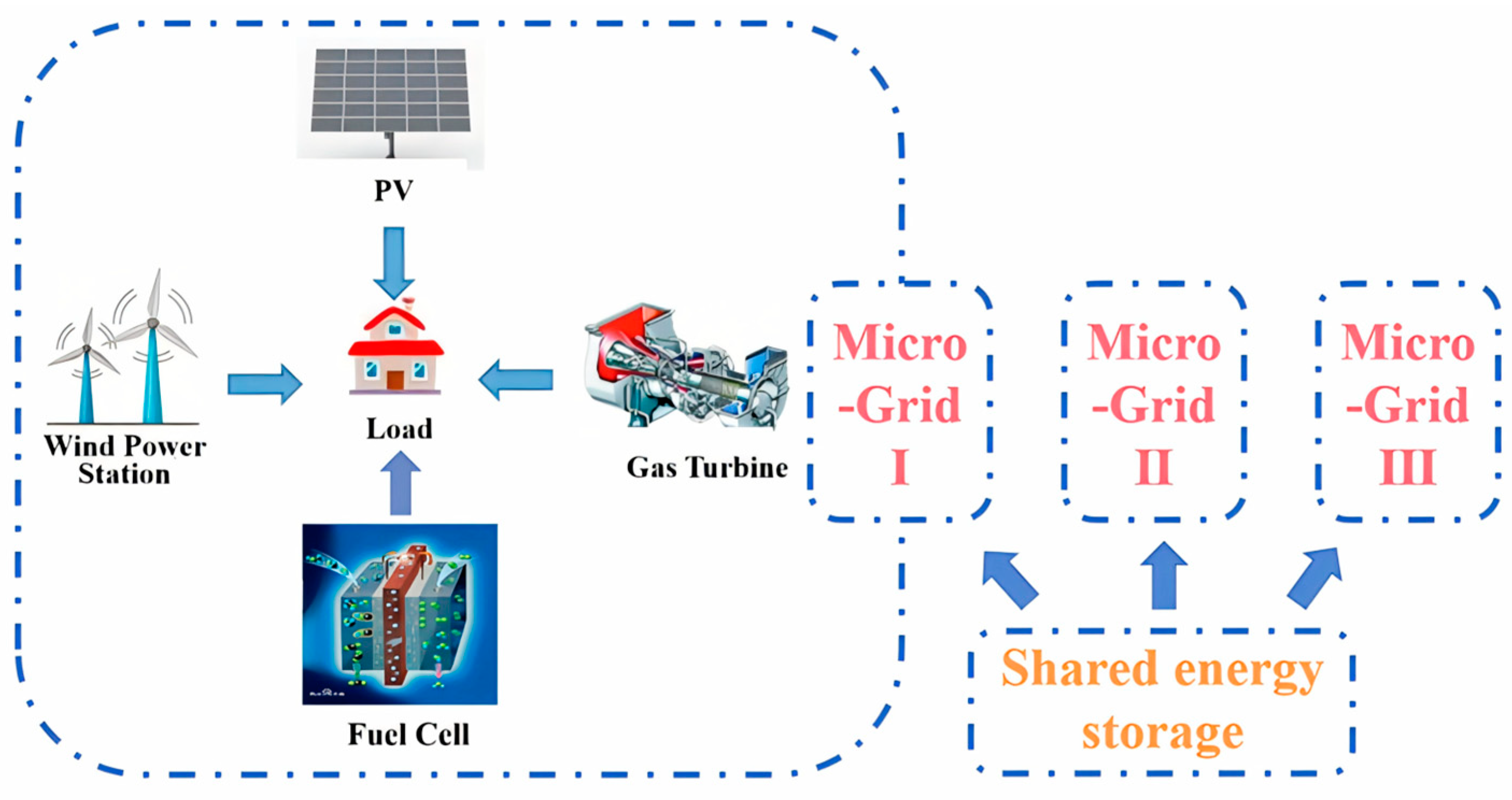

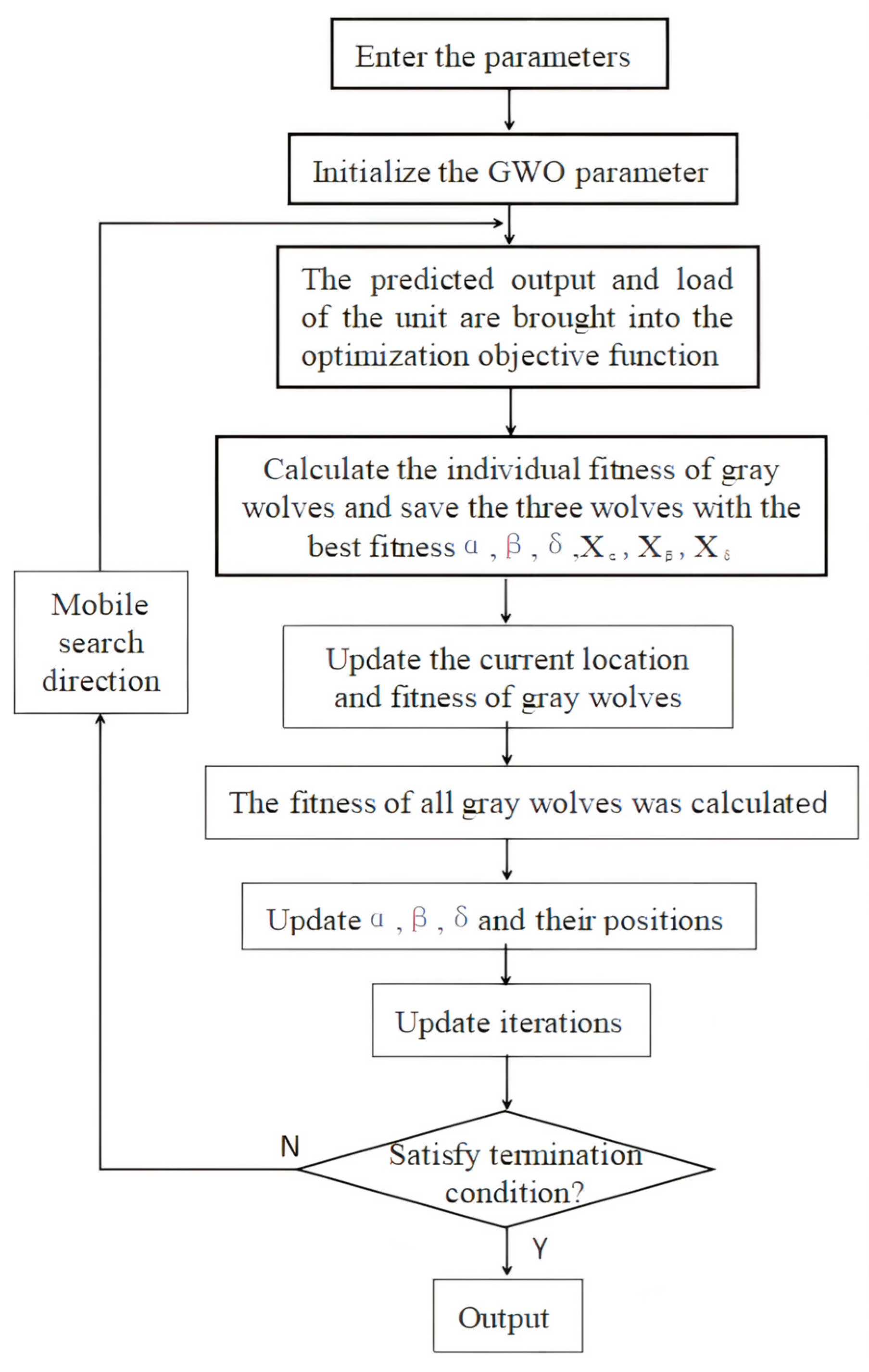
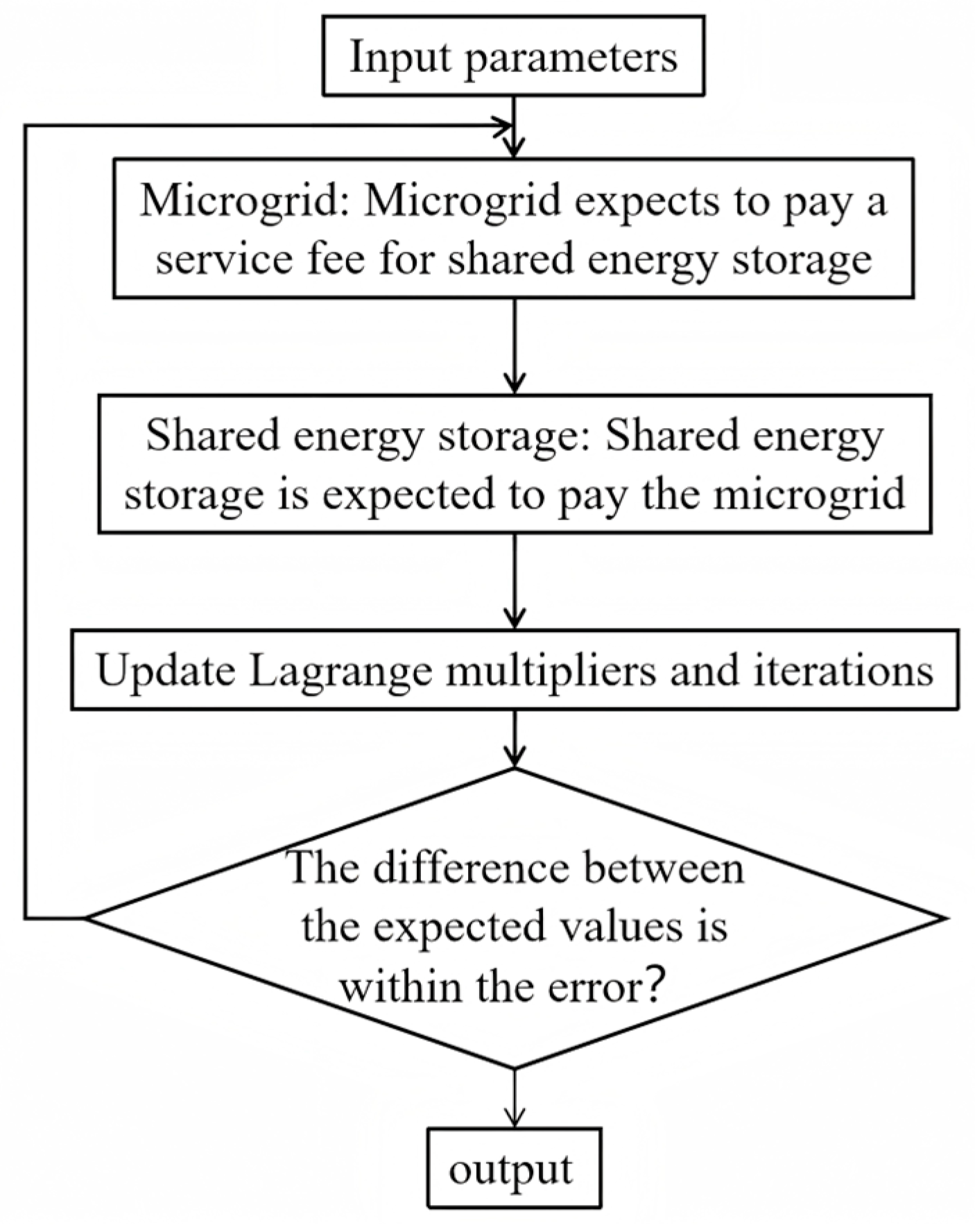
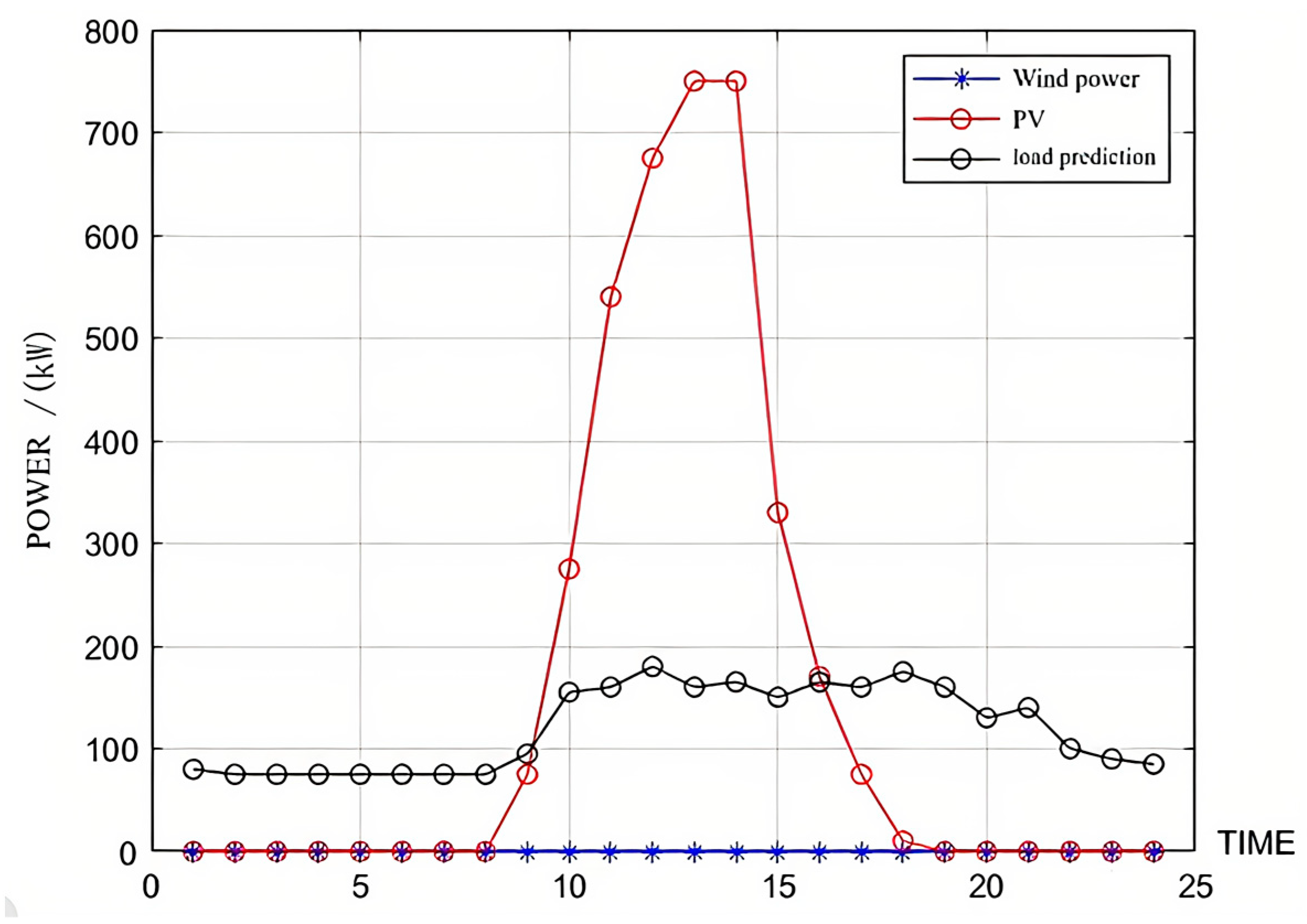
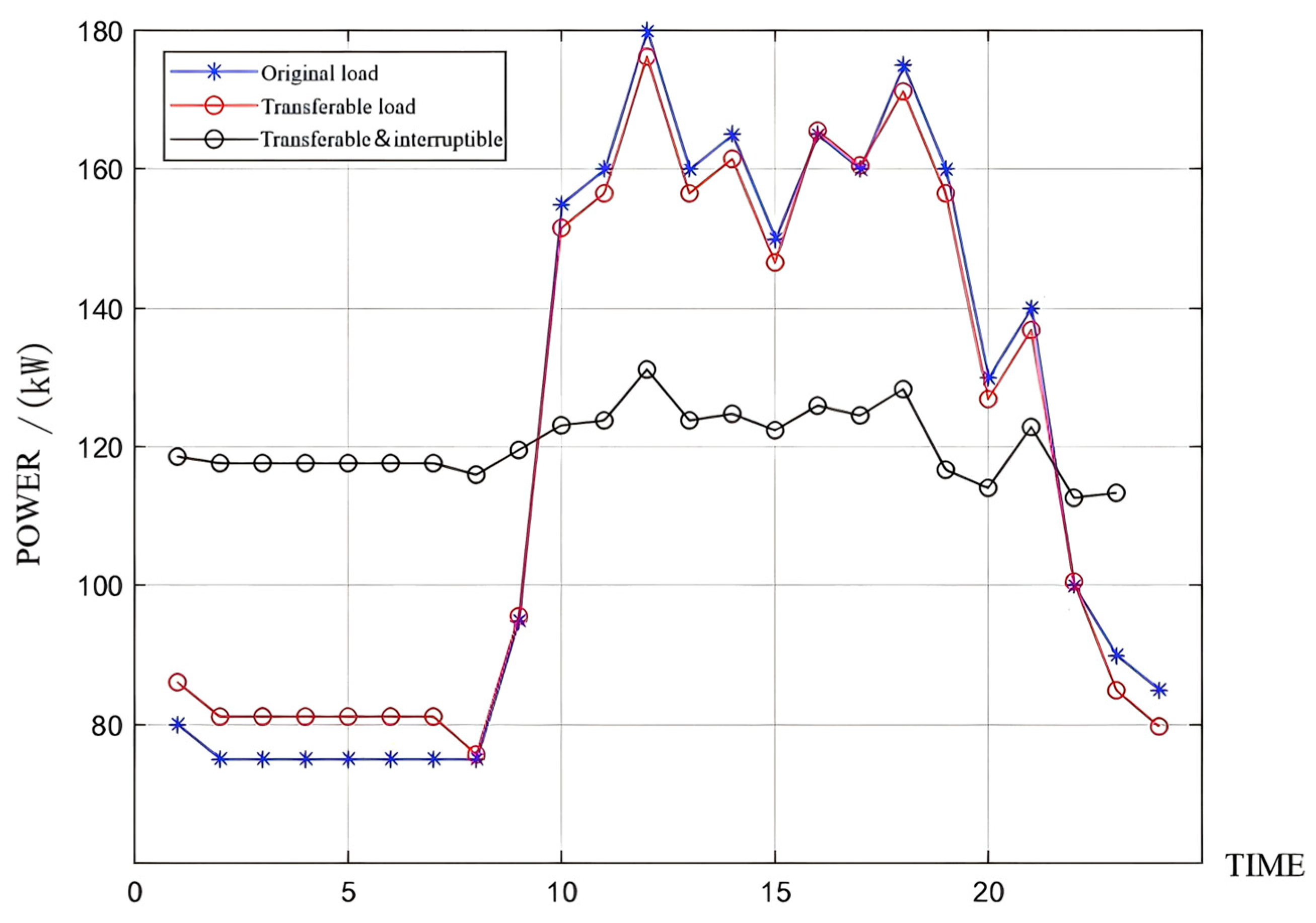

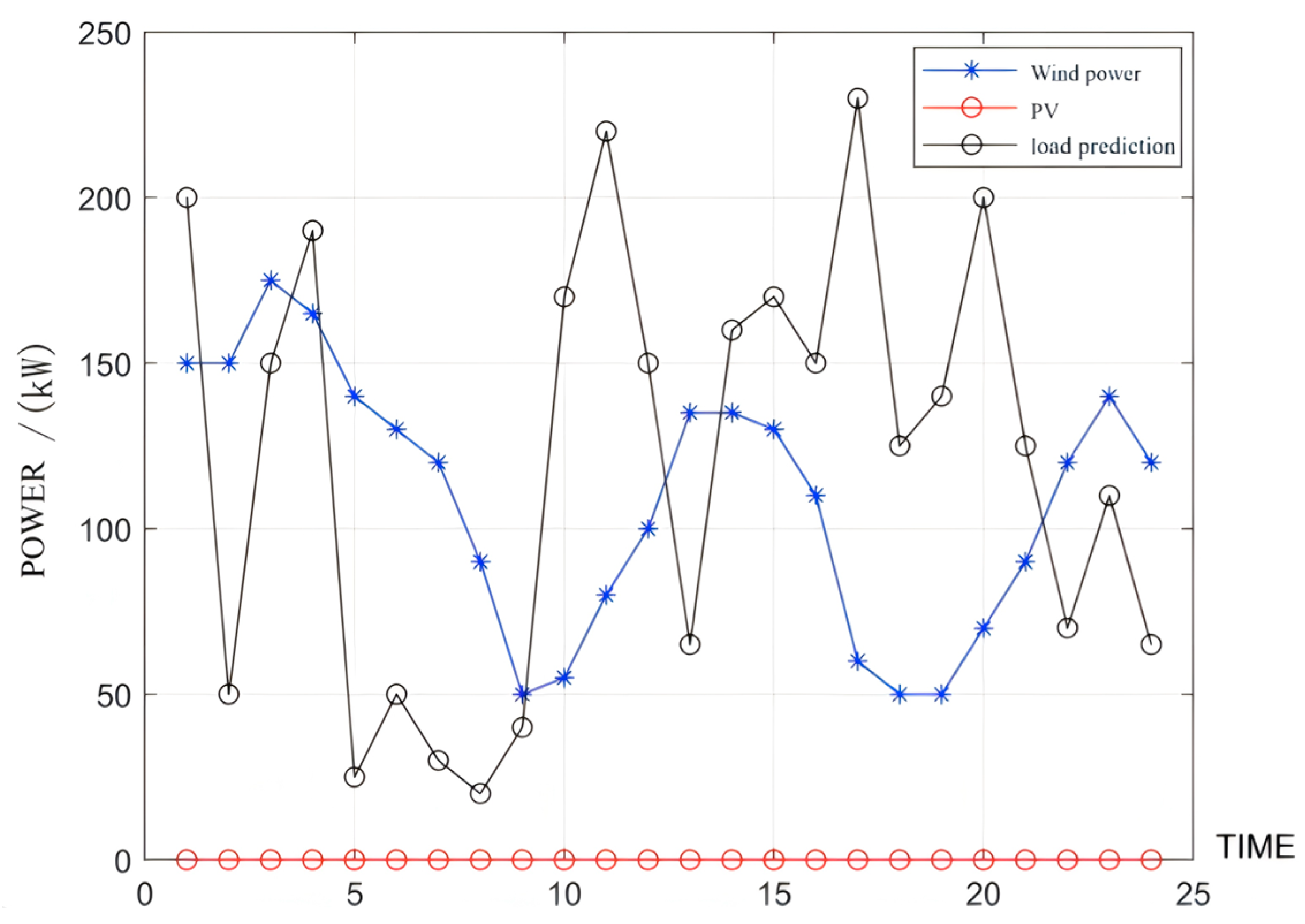

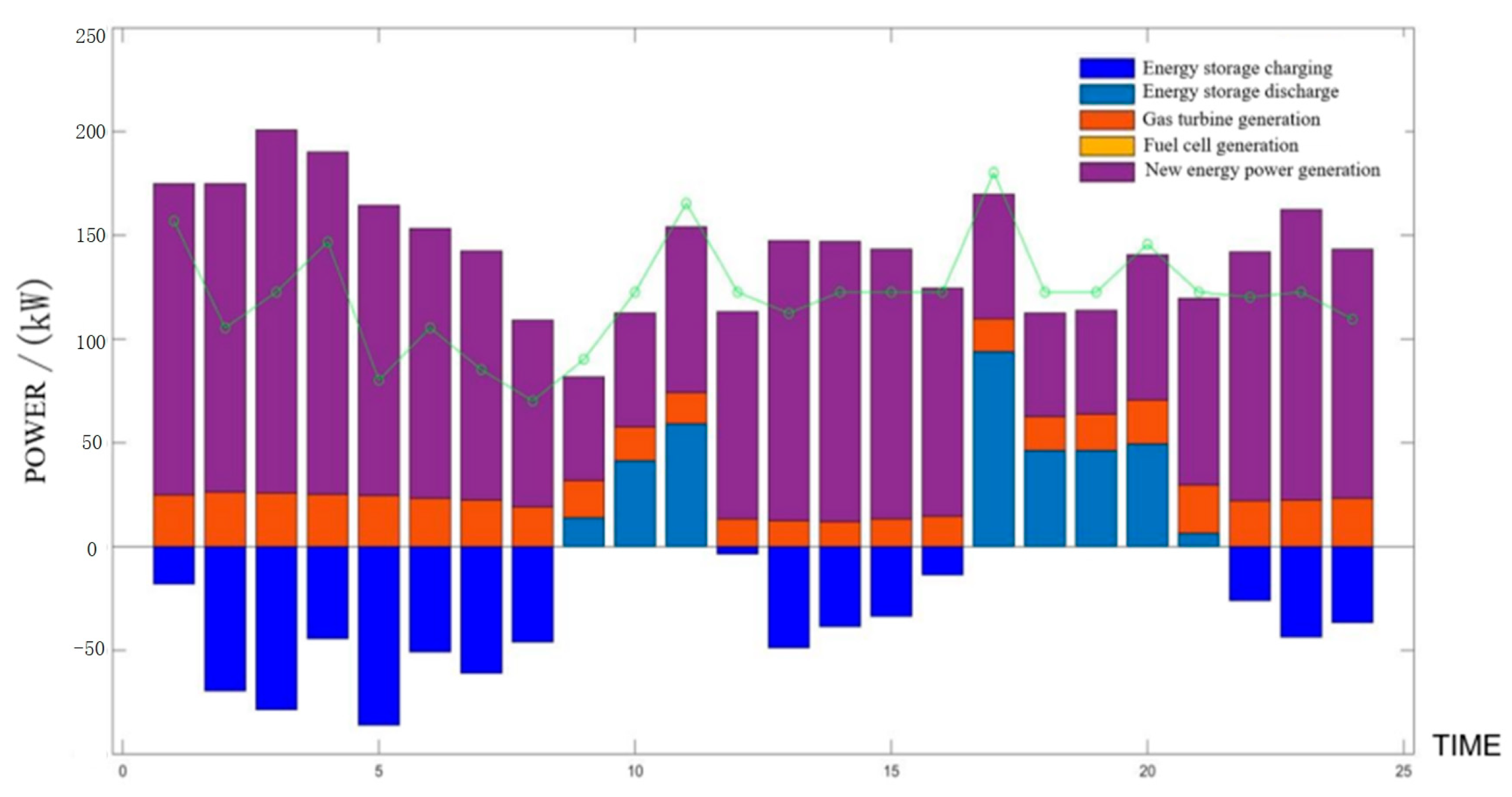

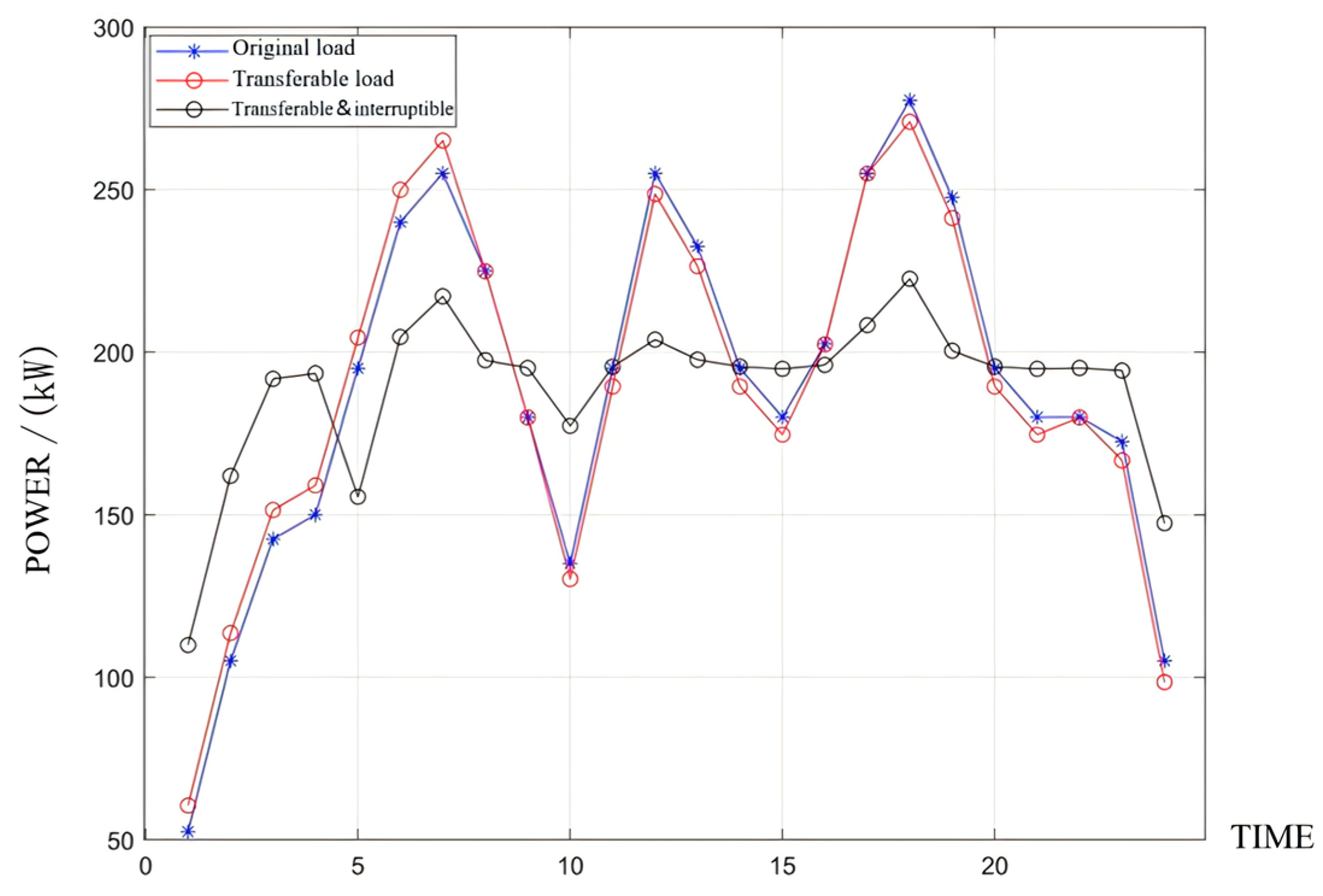
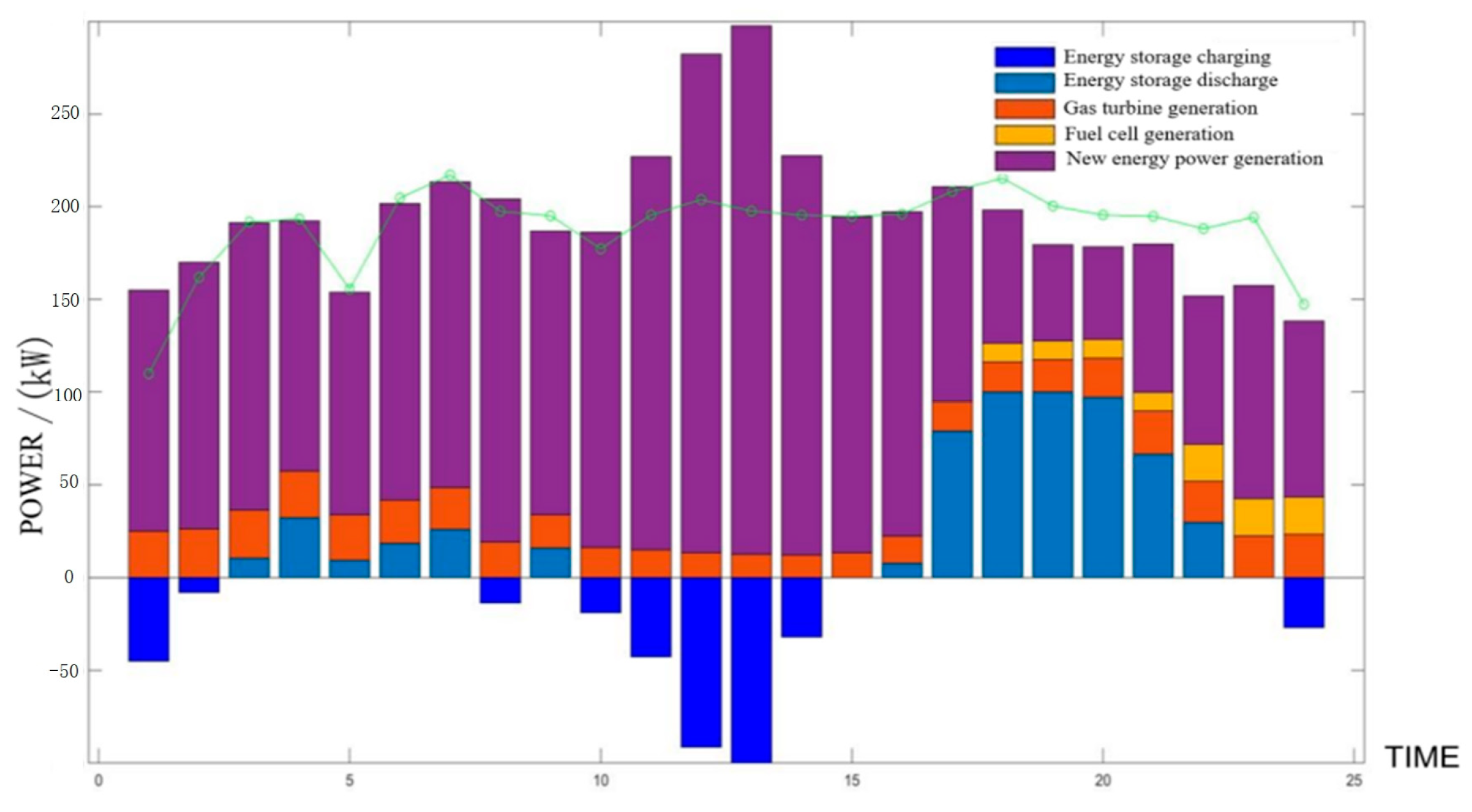
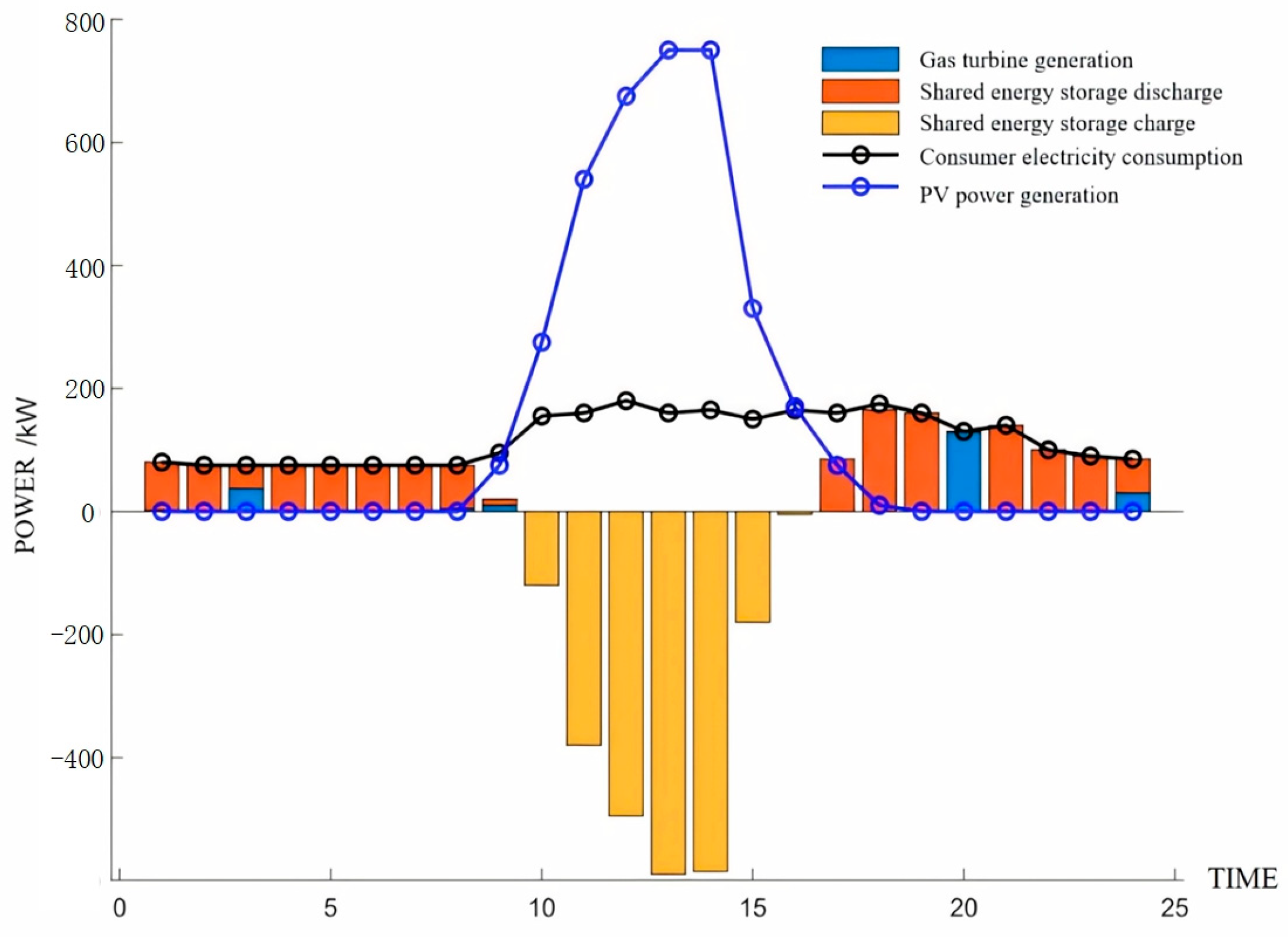
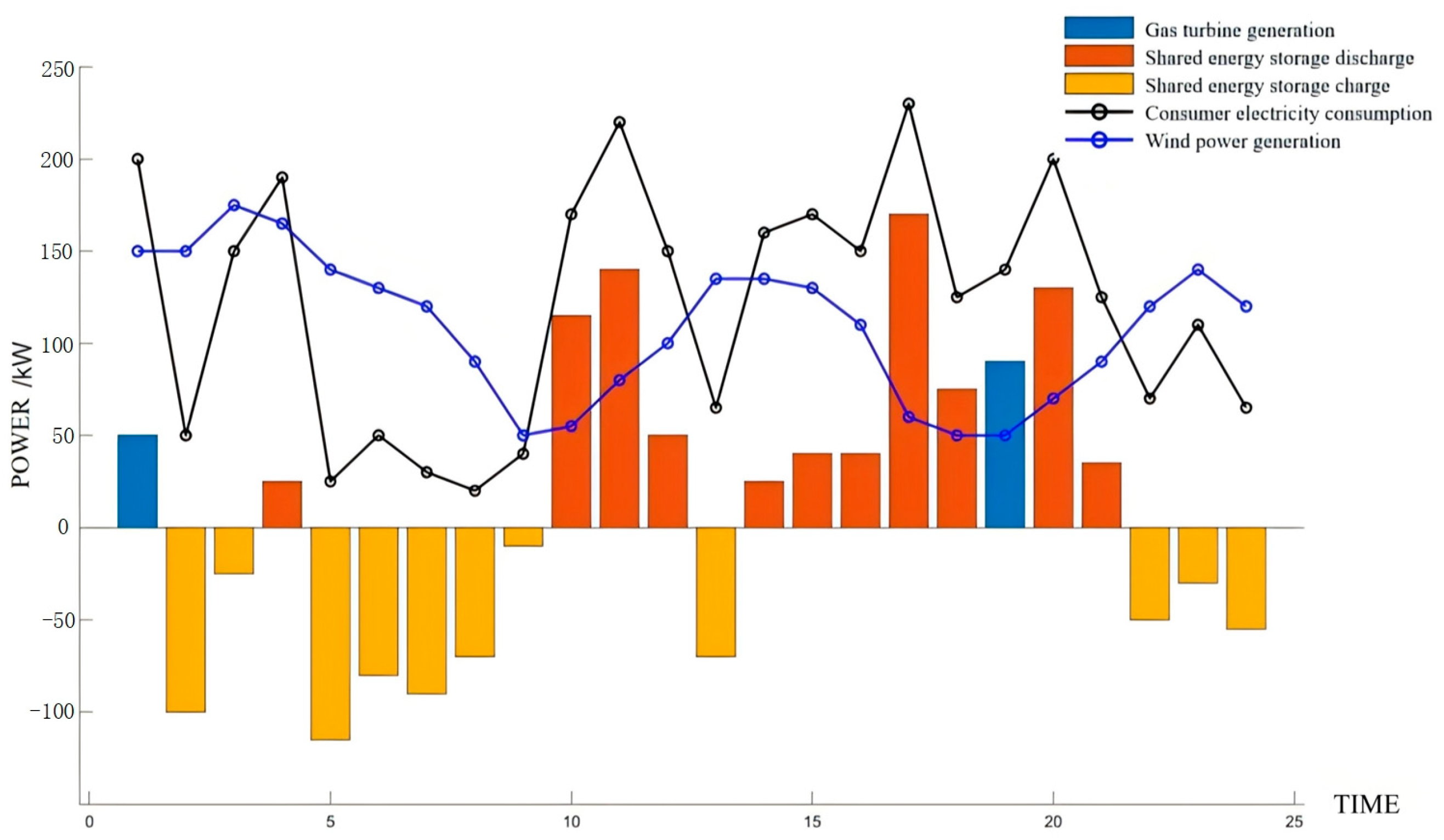

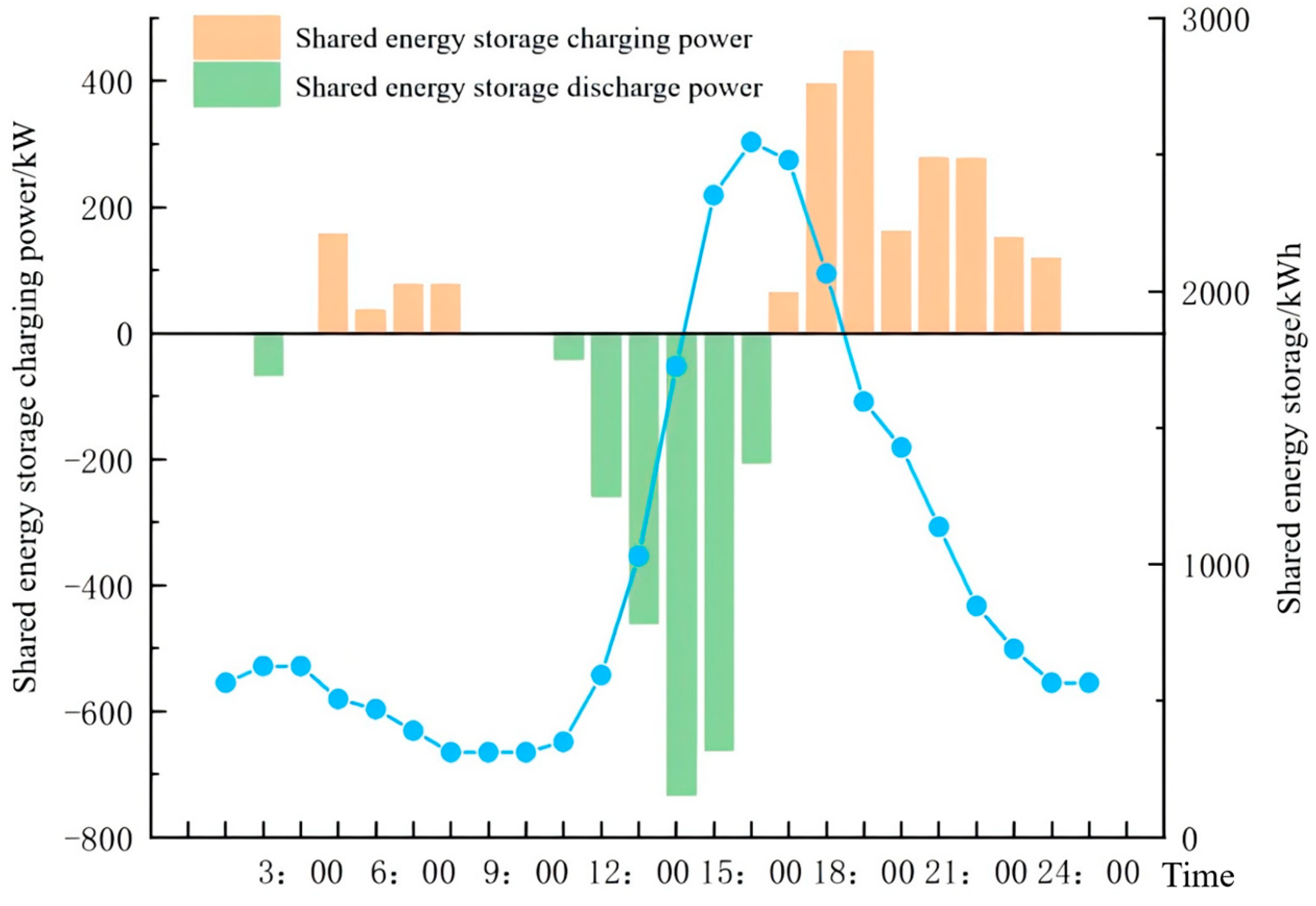
| Energy Storage Capacity/(kWh) | Energy Storage Maximum Charge and Discharge Power/kW | Cost of Operation/Yuan | |
|---|---|---|---|
| Microgrid I | 2796.5625 | 590 | 1625.48 |
| Microgrid II | 739.2434 | 130 | 561.79 |
| Microgrid III | 836.8421 | 195.5 | 754.38 |
| Total | 4372.648 | 915.5 | 2941.65 |
| Algorithm | Number of Iterations | Calculation Time/s |
|---|---|---|
| PSO | 73 | 8.59 |
| GWO | 58 | 7.26 |
| improved GWO | 47 | 5.64 |
Disclaimer/Publisher’s Note: The statements, opinions and data contained in all publications are solely those of the individual author(s) and contributor(s) and not of MDPI and/or the editor(s). MDPI and/or the editor(s) disclaim responsibility for any injury to people or property resulting from any ideas, methods, instructions or products referred to in the content. |
© 2024 by the authors. Licensee MDPI, Basel, Switzerland. This article is an open access article distributed under the terms and conditions of the Creative Commons Attribution (CC BY) license (https://creativecommons.org/licenses/by/4.0/).
Share and Cite
Shi, Z.; Yan, L.; Hu, Y.; Wang, Y.; Qin, W.; Liang, Y.; Zhao, H.; Jing, Y.; Deng, J.; Zhang, Z. Optimization of Operation Strategy of Multi-Islanding Microgrid Based on Double-Layer Objective. Energies 2024, 17, 4614. https://doi.org/10.3390/en17184614
Shi Z, Yan L, Hu Y, Wang Y, Qin W, Liang Y, Zhao H, Jing Y, Deng J, Zhang Z. Optimization of Operation Strategy of Multi-Islanding Microgrid Based on Double-Layer Objective. Energies. 2024; 17(18):4614. https://doi.org/10.3390/en17184614
Chicago/Turabian StyleShi, Zheng, Lu Yan, Yingying Hu, Yao Wang, Wenping Qin, Yan Liang, Haibo Zhao, Yongming Jing, Jiaojiao Deng, and Zhi Zhang. 2024. "Optimization of Operation Strategy of Multi-Islanding Microgrid Based on Double-Layer Objective" Energies 17, no. 18: 4614. https://doi.org/10.3390/en17184614
APA StyleShi, Z., Yan, L., Hu, Y., Wang, Y., Qin, W., Liang, Y., Zhao, H., Jing, Y., Deng, J., & Zhang, Z. (2024). Optimization of Operation Strategy of Multi-Islanding Microgrid Based on Double-Layer Objective. Energies, 17(18), 4614. https://doi.org/10.3390/en17184614





